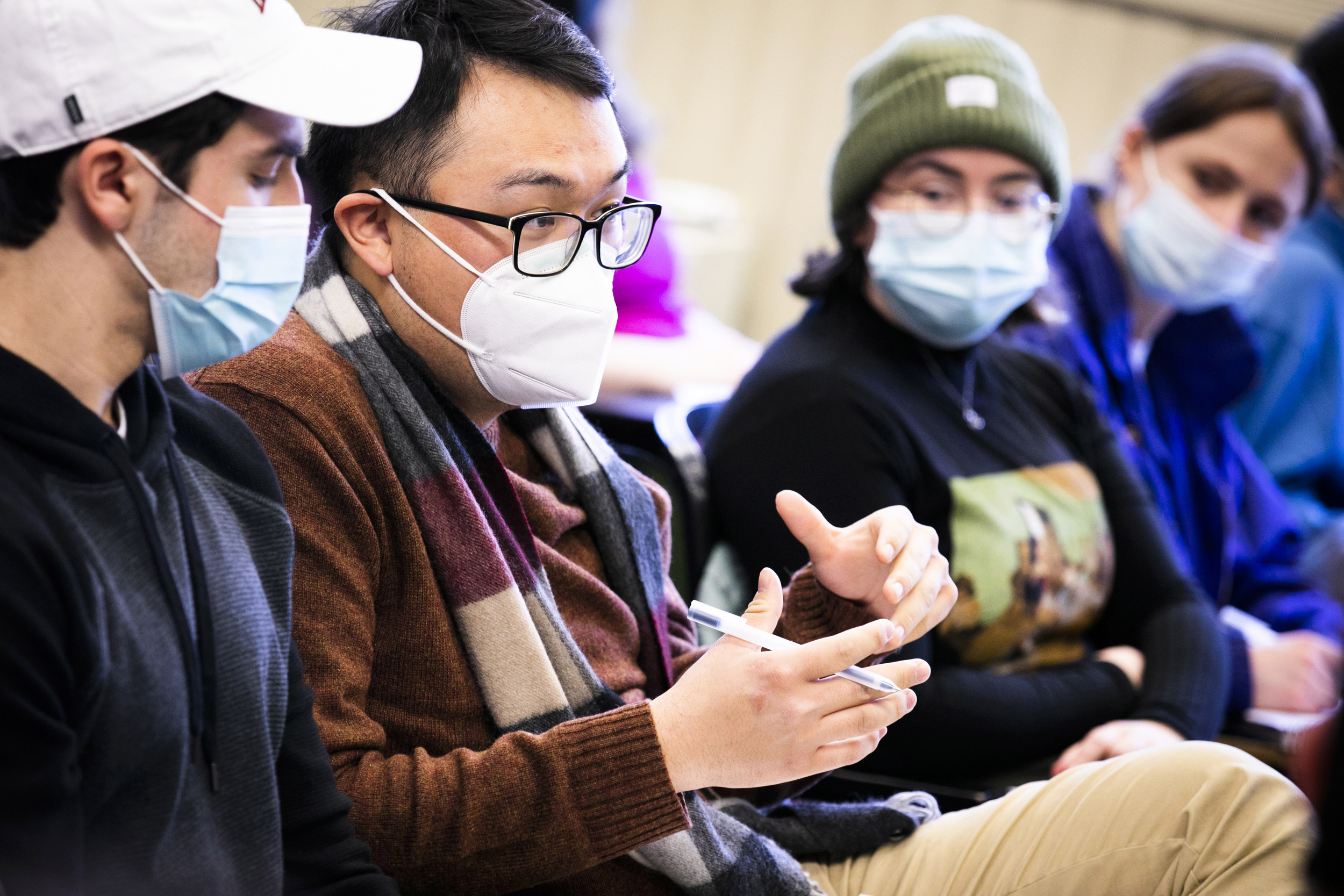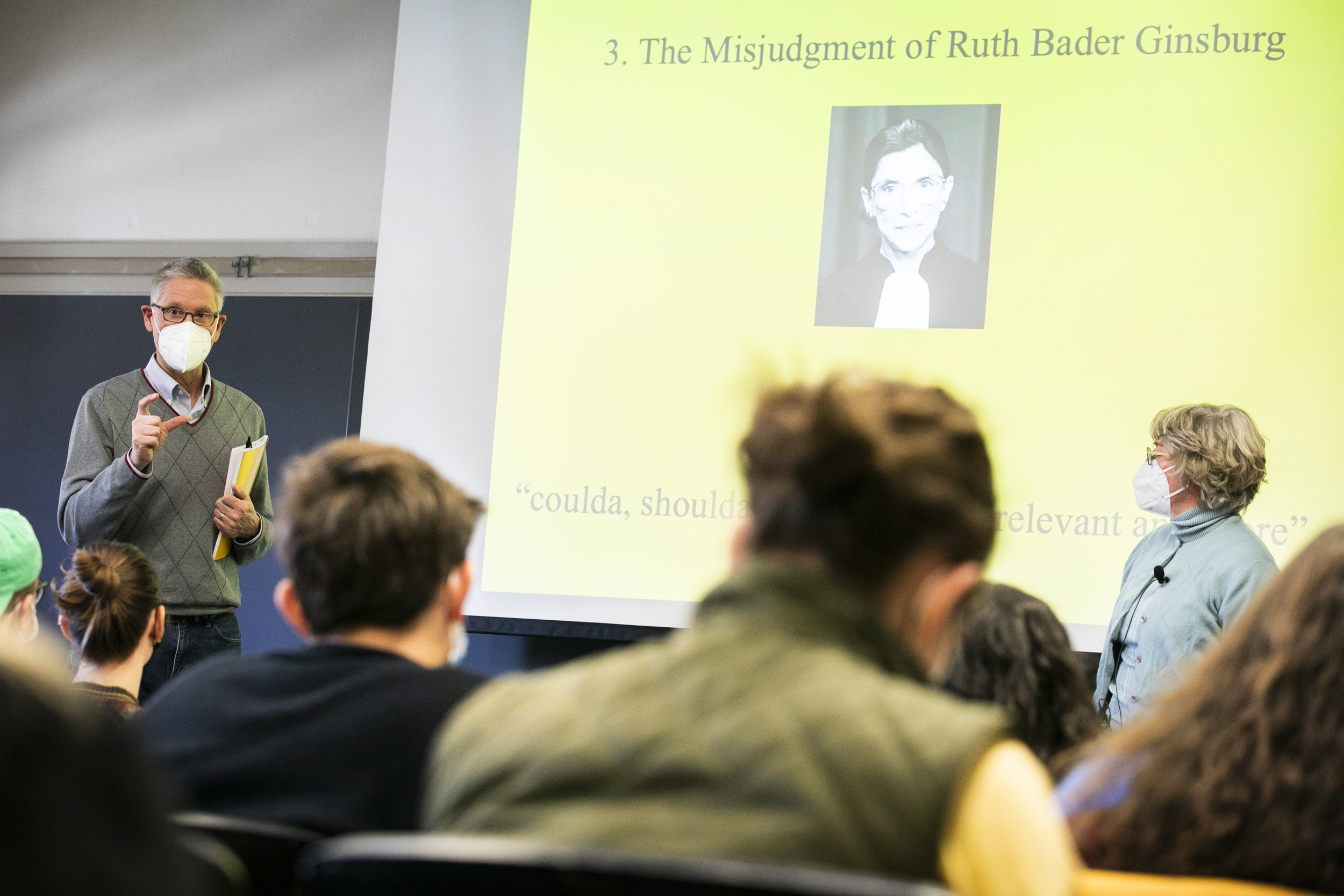
Student Charles Hua (second from left) asks a question in class.
Photos by Stephanie Mitchell/Harvard Staff Photographer
Reframing American Studies
Scholar encourages students to push boundaries of discipline
On the first day of his new spring course, “Making Sense of America: Introduction to American Studies,” Philip J. Deloria started with a story. Actually, he started with six of them.
“We discussed ‘The City on a Hill,’ the Founding Fathers, the frontier, the bloody redemption of the Civil War, the melting pot, and the self-made man — the master narratives of American history,” said Deloria, Leverett Saltonstall Professor of History and chair of the committee on Degrees in History and Literature.
One of Deloria’s goals for the History and Literature course — open to all undergraduates — is for students to “wonder about what new kinds of storying might be available in order to make sense of the present and future of the nation,” beyond the messages of its myths.
“American Studies is not simply about the formation of national boundaries and what happens within them, and it’s not a nationalist discipline or practice,” he added. “But it does spur us to think about things about this country that are valuable, important, and worth holding onto. This is a field that our students are hungry for right now, so they can learn how to think through these kinds of questions.”
To help students explore overlap between American Studies and other disciplines, Deloria has welcomed colleagues to the class for guest lectures on a range of subjects. They have included Jesse McCarthy, an assistant professor of English and of African and African American Studies; Eleanor Craig, program director for the Committee on Ethnicity, Migration, and Rights and a lecturer in the same field and in Studies of Women, Gender, and Sexuality; and Matt Saunders, a professor of Art, Film, and Visual Studies, who will host a screen-printing workshop at the Carpenter Center for the Visual Arts as part of a unit on the arts in American Studies.
“I think it’s a service to the students to see these disciplines and areas of work presented in a thematically coherent way,” said Deloria. “American Studies has always been a critical discipline, and a socially engaged, problem-centered way of thinking, and much more open to thinking about transnationalism, ethnic studies, Indigenous studies, vernacular culture, and other interests.”
Phil Deloria (left) speaks during a class featuring Jill Lepore as guest speaker in Sever Hall.

The multifaceted syllabus has given Charles Hua ’22-’23, a statistics and mathematics concentrator, a chance to engage with the humanities and social sciences. It’s also helped him learn more about the “concept of America.”
“I’ve been developing a deeper understanding of this country, motivated by a couple of cross-country train trips I’ve taken, and I haven’t gotten to explore in-depth many of the interesting questions about its richness and diversity before,” said Hua, who grew up in Madison, Wisconsin. “The class has absolutely lived up to those expectations that I had about getting to try out those different ways of thinking about the country we live in.”
Another foundational element of the course is its emphasis on public-facing writing, which Deloria describes as one of the hallmarks of American Studies. For the final project, students are required to write a cultural analysis piece similar to essays that appear in The New Yorker, The Atlantic, and The New York Times Magazine.
“One of the great contributions of the United States to the literary world in the present moment is creative nonfiction writing, and American writers are particularly good at this,” he said.
In unit on history and historical writing, Jill Lepore, David Woods Kemper ’41 Professor of American History and a New Yorker staff writer, spoke about the process behind one of her magazine essays. Lepore, who received a Ph.D. in American Studies from Yale, said that “the humanities give us a trunkful of tools” for analysis, including close reading, archival research, and critical-thinking skills. She encouraged students to “go to the primary sources with a question, not an answer.”
Annabelle Krause, a first-year student from New York, applied what she learned about integrating humanities research with popular culture to write a short essay about the place of Taylor Swift in American society.
“Many of our assignments are about taking something and learning how to understand its deeper meaning or why you care about it,” she said. “We’re learning a different way of presenting things to the world beyond pure academia. I love that the course is flexible and engaging with us as people.”
Helping students see themselves in the discipline — and parlaying their interests into cultural critique and analysis — is another component of Deloria’s mission to reframe the field.
“American Studies is a way of life,” he said. “It’s a self-disciplined practice of looking very, very closely at things, seeing them from multiple angles, finding practical utility in them, and looking — in a future-facing and public-facing way — toward making an actual contribution to the social good.”




